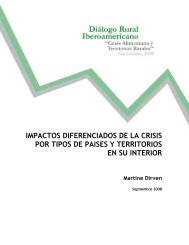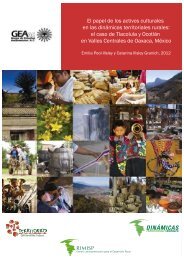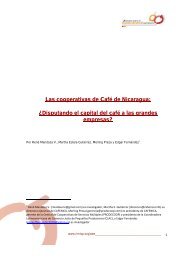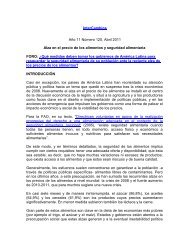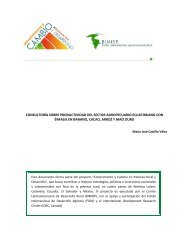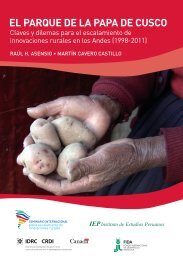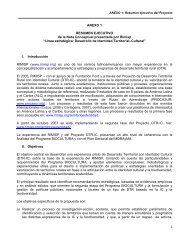Vietnam's Agrarian Reform, Rural Livelihood and Policy ... - Rimisp
Vietnam's Agrarian Reform, Rural Livelihood and Policy ... - Rimisp
Vietnam's Agrarian Reform, Rural Livelihood and Policy ... - Rimisp
Create successful ePaper yourself
Turn your PDF publications into a flip-book with our unique Google optimized e-Paper software.
1986. The gap between free market <strong>and</strong> official prices was 10 times or more. Per capita foodproduction fell below the minimum needed level of 300 kilograms a year. People were going hungryagain (Beresford <strong>and</strong> Fforde, 1996; Nguyen K.V., 1990; Nguyen, D.A.T, 2006).1.2. <strong>Agrarian</strong> <strong>Reform</strong>: 1988-2000Under the Doi Moi reform process adopted in December 1986, the collective agriculture system beganto be dismantled. The reforms had sweeping goals: they sought to stabilize the economy, develop theprivate sector, increase <strong>and</strong> stabilize agricultural output, shift the focus of investment from heavy tolight industry, focus on export-led growth, <strong>and</strong> attract foreign investment.It was not until 1988, however, that the Communist Party issued Resolution 10, which shifted the focusof rural development from collectives to household production. Resolution 10 obliged the agriculturalcollectives to contract l<strong>and</strong> to households for 15 years for annual crops <strong>and</strong> 40 years for perennialcrops. Households were allowed to buy <strong>and</strong> sell animals, equipment, <strong>and</strong> machinery. They still had tomeet production quotas, but the production amounts <strong>and</strong> prices were fixed for five years, givinghouseholds a degree of certainty that they had previously lacked. The private sector was allowed toengage in food marketing.Further reforms followed. From 1987 to 1991, the government relinquished control over prices <strong>and</strong>opened markets for both domestic <strong>and</strong> international trade. In 1989, it sharply devalued the country’scurrency, making Vietnamese exports much more competitive on international markets (Fforde <strong>and</strong> deVylder, 1996; Sepehri <strong>and</strong> Akram-Lodhi, 2002).The reforms unleashed a surge of entrepreneurship <strong>and</strong> productivity. Agricultural growth jumped,reaching 3.8 percent a year from 1989 to 1992. As the government retreated from controlling markets<strong>and</strong> prices, farm households had new incentives to produce more <strong>and</strong> sell their surpluses. Vietnam,which had imported more than 460,000 tons of food in 1987 <strong>and</strong> again in 1988 to meet shortfalls innational production, became the world’s third-largest exporter of rice in 1989, alleviating national foodshortages <strong>and</strong> generating large amounts of foreign exchange for the country (Dang, K.S. et al. 2005;Nguyen, D.A.T, 2006).4




